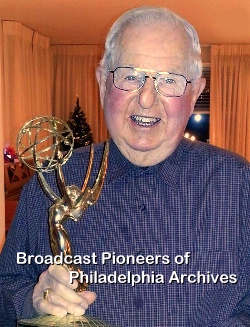

Broadcast Pioneers Board Member Richard L. (Dick) Kearney was born at home on September 7, 1925 on Park Avenue now part of the Temple University campus. He attended LaSalle College High School until he was lured away with a full football scholarship to Brown Prep. Dick joined the Navy after high school and was a sonarman in World War II, serving on a destroyer escort in the Pacific theater. After the war, he took his Navy electronic experience and his GI Bill and earned an electronics technician degree from Temple University. At this time he also served as First Sergeant, Headquarters Battery, 166th Field Artillery, Pennsylvania National Guard.
Dick came to WCAU TV in 1950 just two years after Philadelphia’s third television station went on the air. Living with his new wife Angie in Philadelphia’s West Oak Lane, he commuted to WCAU’s studios at 1622 Chestnut Street. Two years later in 1952, WCAU moved to Bala Cynwyd occupying a new state-of-the-art television center. The station claims that it is the first building in America constructed specifically for broadcasting. Dick was involved in that move and was part of the original crew operating the modern equipment.
To be closer to the new studios, Dick moved his family, now with two sons, to Havertown in 1954. His new home was seven miles from the WCAU studios, a distance Dick knows well because in the days of live television Dick walked to work when it was impossible to drive during many of the large snowstorms of the early ‘60s.
In the early days of the Bala Cynwyd studios, Dick was in the original crew of “Action in the Afternoon” a live show starring Jack Valentine that was broadcast on the back lot of the new studio. It was live on the CBS television network. The set was somewhat secluded because back then the area around the complex was wooded, but the occasional overhead aircraft could be heard. Also telecast from the back lot was the morning farm show with Bill Bennett. Dick’s sons, now numbering 3, would wake up early in the morning to hear the banter and see the antics of Bill Bennett and his technical crew.
In his 40 years at WCAU-TV, Dick Kearney was an integral part of much of the television history made there. From the Facenda newscasts to Ed McMahon’s Home Highlights Show, to the childrens’ shows, such as Gene Crane, Gene London, and Pixanne.
Dick Kearney was a key member of the crews that produced “remote broadcasts.” In those days, camera cable was thick and heavy and the cable had to be strung and removed for each broadcast. Cameras were large, bulky and difficult to transport. These were the rare occasions that the technical crews did not wear coats and ties.
Dick remembers doing remote broadcasts of the Phillies and A’s baseball teams in his early days at WCAU TV. Back then the on-field camera was set up just behind the catcher.
Later, Dick was part of the Philadelphia Orchestra’s live broadcasts from the Academy of Music. Dick’s camera was precariously positioned on a platform built over the rails of the upper balcony until one year was assigned the on-stage camera where he interacted with Maestro Ormandy.
WCAU-TV made history in its football broadcasts. Tony Verna, Joe Sidlo and Dick introduced a new technology into the 1963 Army-Navy Game. Videotape machines had just been invented. Tony had an idea for a new use for the machine. With Tony directing, Dick would follow a player on one side of the field and Joe the other. This became known as the “isolated camera” and became part of WCAU’s coverage of the Eagles at Franklin Field. Over the years, Dick demonstrated his superior football acumen by suggesting to Tony which player he should follow on isolation. CBS Sports took notice of this broadcast team and they were on occasion selected to work away games. .
Dick’s good reputation with CBS Sports led to his working the Master’s Golf Tournament at Atlanta, Georgia where he and his team received an Emmy award in 1981.
Over the years, Dick met three US presidents at WCAU. Eisenhower, Kennedy, and Reagan. Kennedy made a campaign appearance at WCAU in 1960 and at one point sat down on Dick’s camera dolly and took off his shoes, saying that his feet were hurting.
Dick was fond of working remotes at the Gimbel’s Thanksgiving Day Parades and Mummers Parades. His three young sons would meet him at the broadcast truck and watch from the base of his camera. Dick’s last Mummers Parade was with Larry Kane hosting.
Dick retired from WCAU in 1990 after 40 years. Since that time he has been active in the Broadcast Pioneers, serving as a board member since 2000. His is also active in the Philadelphia Council of the Navy League as a director and is a member of the Destroyer Escort Sailors Association.
From the official archives of the Broadcast Pioneers of Philadelphia
© 2015, Broadcast Pioneers of Philadelphia
All Rights Reserved
The e-mail address of the Broadcast Pioneers of Philadelphia is pioneers@broadcastpioneers.com